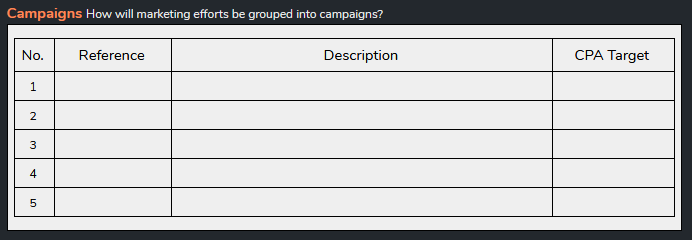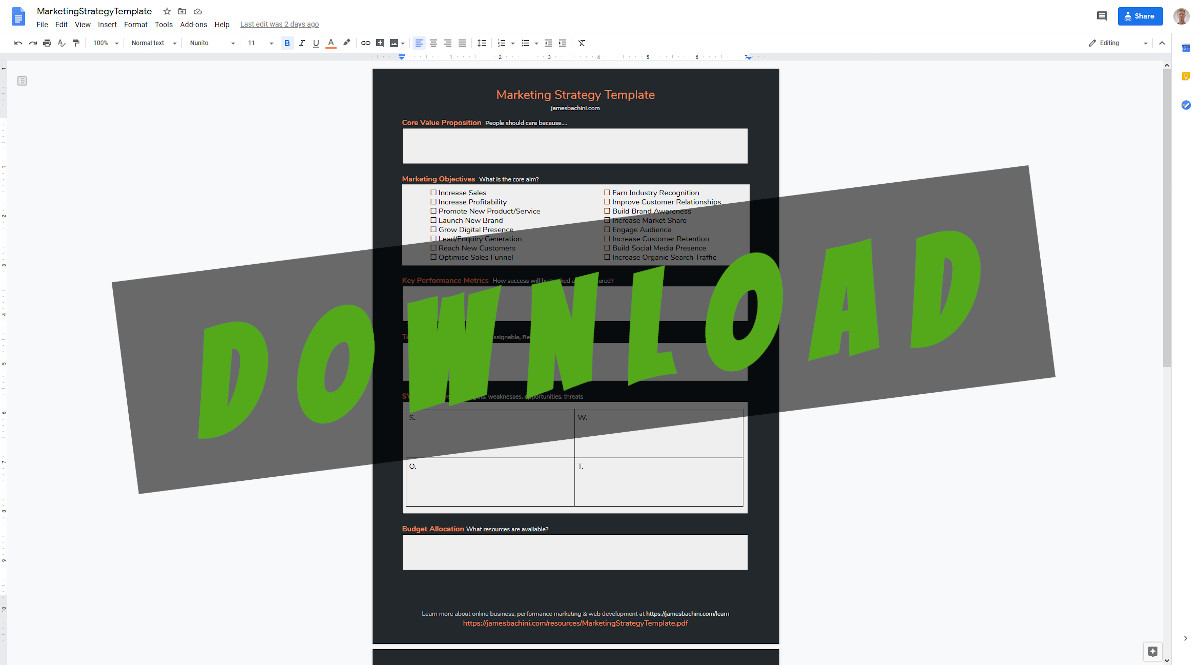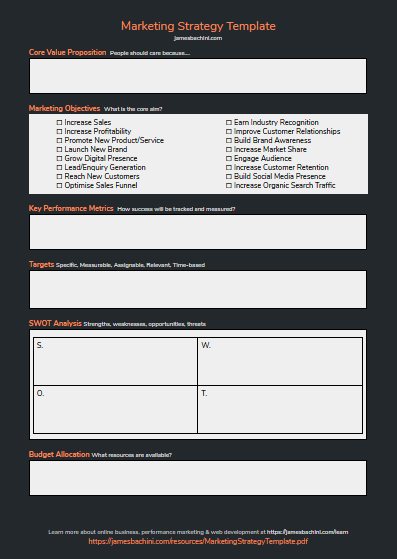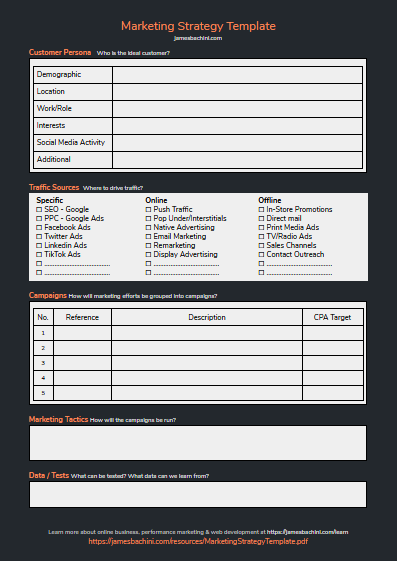This free marketing strategy template provides a framework from which to plan out modern marketing activities. Follow the link below to download the document in Google docs, .pdf, .doc (word) and .odt format.
- Marketing Strategy Template Explained in 90 seconds
- Download the Template
- Core Value Proposition
- Marketing Objectives
- Key Performance Metrics
- Targets (SMART)
- SWOT Analysis
- Budget Allocation
- Customer Persona
- Traffic Sources
- Campaigns
- Marketing Tactics
- Data / Tests
- Conclusion
Marketing Strategy Template Explained in 90 seconds

Download the Template
The marketing strategy template is available to download in the following formats.
Now let’s do a deep dive into the individual sections and concepts to get the most out of the marketing strategy planning.
Core Value Proposition
The core value proposition is where every marketing strategy should start out. Why should consumers care about what you are doing? How does it benefit them?
The core value proposition should be a short, concise description of how your product adds value and creates customer appeal.

Marketing Objectives
What are the core objectives of the marketing campaign? This will likely span more than one field in the marketing strategy template.
Increase Sales
Boost revenues and income through higher levels of sales. Selling more products has a secondary effect on brand awareness and potentially higher repeat business from existing customers.
Increase Profitability
Ultimately business is about being profitable and marketing is a factor that can lead to greater profits. With more efficient marketing, profits should increase however it’s important to note whether this will be a direct response or long-term effect.
Promote New Product/Service
So you’ve spent time creating this new product or service but no one knows about it. This marketing objective is to bring in an initial audience of early adopters.
Launch New Brand
Launching an entire new brand is one of the hardest things to achieve. The brand needs a focused message that resonates with a target audience. Retargeting can be used to provide the impression of the brand being everywhere to the segmented audience.
Grow Digital Presence
Whether you are looking to increase your personal or business profile, the online space offers scalable reach to an almost unlimited audience. Digital PR and a strong content strategy are key to generating a high profile online presence.
Lead/Enquiry Generation
Direct response campaigns are well suited to lead generation, where the exact metrics can be measured and budgeted for. The goal of most lead generation campaigns is to lower the cost per acquisition (CPA).
Reach New Customers
It is much harder to sell a product to someone that has never heard of your brand before. Reaching a new customer base may mean expanding into new markets or targeting different demographics in existing ones.
Optimise Sales Funnel
A secondary objective of many marketing campaigns is to continuously improve the conversion funnel. Always be testing, analysing and improving. Unprofitable campaigns can still be beneficial if the data is being used to increase the efficiency of the sales funnel.
Earn Industry Recognition
By raising social status within an industry it opens doors to new opportunities. Speaking at events, networking, access to other industry leaders.
Improve Customer Relationships
The customer comes first and marketing can play a big part in building customer relationships. By improving communications between the company and the customer we can build trust and rapport benefiting the brand perception.
Build Brand Awareness
When a consumer recognises a brand it lowers the barrier to a sale. By building brand awareness a company can put themselves in the mind of the customer who will associate the company with the brand’s message. Work to build trust in your brand with your dream customer base.
Increase Market Share
Increasing market share in competitive industries is key to increasing volumes and benefiting from economies of scale. Effective marketing can increase sales and customer numbers pushing up the market share over competitors.
Engage Audience
Engaging an initial audience through interaction with an ad, article, or video, allows the marketer to segment that audience. Retargeting campaigns can then be run just to that audience who interacted with the first campaign.
The lead is warmer because it’s pre-qualified based on interest in your content and they’ve already interacted with your brand previously. This provides higher conversion rates at later stages of the funnel.
Increase Customer Retention
Increasing customer retention leads to more sales in the long-term and higher lifetime value (LTV). Customer relationship management systems like Salesforce can be integrated with automated and manual marketing systems.
Build Social Media Presence
Social media organic reach is lower than ever but a strong brand presence can build rapport with potential customers. Whether through organic reach or paid advertising social media network marketing can scale well.
Increase Organic Search Traffic
Search engine traffic is great because it is reaching a customer directly when they are actively searching for a product. SEO or search engine optimization is the method of creating great content and promoting it to gain favour and move up the search engine rankings.
Key Performance Metrics

Key performance indicators or KPI’s are the most critical metrics that make the most difference to your business. Organisations use KPI’s to focus efforts in the right areas and to measure and evaluate performance.
| Financial KPIs | Customer KPIs |
| Revenues EBITDA, Earnings Before Interest, Taxes, Depreciation & Amortization Segmented revenue by product/location/campaign Fixed Costs Product Costs Profit margins Burn rate (funding runway remaining) Growth rate Market share Quick ratio / Acid test ROI Return on investment Operational cash flow | Customer lifetime value 7 or 30 day customer retention Churn rate Repeat purchase percentage Cost per new customer acquisition Customer satisfaction |
| Organisation KPIs | Marketing KPIs |
| Customer support response time Employee satisfaction Employee turnover rate R&D results Time to Market Milestones Inventory levels Order Fulfillment Time | CPA – Cost per action/lead Lead to sale conversion rate Monthly volumes Abandoned cart ratio Average order value Monthly visitors/users Press releases published Social indicators, follows, likes |
Targets (SMART)
Make yourself accountable by setting clear targets and reviewing throughout the lifetime of a marketing campaign.
I recommend the smart goals framework which is:
- Specific – Make your goal quantifiable rather vague and open to interpretation.
- Measurable – Ensure you are tracking the relevant data or KPI’s to measure your success in relation to the goal.
- Attainable – Goals should be optimistic but not unrealistic.
- Relevant – The goal should be something that moves the needle for the business.
- Time-Based – The goal should have a specified time-frame or deadline.
The smart framework enables targets to be set which are monitored for progress and provide a clear picture of marketing success.
SWOT Analysis
SWOT analysis stands for strengths, weaknesses, opportunities, threats. It’s an age old exercise to evaluate the current position of an organisation. Here are some examples.
| Strengths Internal talent (design skills, marketing) Funds available Early entry to market Industry connections Strong market demand | Weaknesses Missing internal skill sets Reliance on external contractors Specific weakness related competitors Dependency on X Lack of product differentiation |
| Opportunities New platforms and channels Viral/Word of mouth growth Press interest Improving marketing efficiencies | Threats New competitors entering the market Financial restrictions Changing markets due to coronavirus Market saturation |
Budget Allocation

Budget can be broken down into three parts, time, resources and funds.
Time Requirements
How much manpower is required to execute this marketing strategy? How many people will be involved and does everyone have the ability to commit the required amount of effort?
Resources
Does the marketing strategy require new landing pages, banner designs, video ads, SaaS platforms? What resources are required to execute?
Funds
How much will this cost is going to be the main question for execs. While some campaigns go on to scale and expand on their own when profitable it’s a good idea to set a specific budget at the start.
Looking at the budget allocation allows us to take a step back and assess the risk vs reward.
Customer Persona
Many companies will say they are building something for everyone and the whole world is their target market. This is rarely the case however and almost every brand has a core audience that it resonates with the most.

When defining a customer persona visualise someone you know or know of that would be the ideal customer.
| Demographic | Age, sex, parent, house owner, apple vs android, type of car |
| Location | Market location, city vs suburbs |
| Work/Role | What is the buyers job role, industry, corporate self image |
| Interests | Does the customer have a specific affinity to any hobbies, interests, genres? |
| Social Media Activity | Different social networks have different demographics. Is your customer more likely to spend time on pinterest or twitch? |
Traffic Sources
Marketing strategy requires reaching an audience. Traffic sources provide the entry point to the funnel where a marketer can capture attention and drive visitors to their offer.
Specific
SEO – Google
Free organic traffic from Google (and other search engines). This is a long-term strategy that can take months if not years to achieve significant results.
PPC – Google Ads
Pay per click ads promotes advertisers text ad listings to the top of the search results. Bid on keywords to drive instant traffic.
Facebook Ads
Facebook ads allows marketers to laser target an audience by interests and affinities. Video or image based advertisements are shown on Facebook and Instagram.
Twitter Ads
Twitter ads does not have the same level of targeting as facebook but it’s still possible to segment an audience by targeting follower look-a-likes.
Linkedin Ads
Linkedin is a professional network which has a very specific demographic. If you have a product that would suit headhunters and the unemployed this is the place to run it.
https://www.linkedin.com/campaignmanager/accounts
TikTok Ads
TikTok is a relatively new social media platform that has a young demographic and plenty of opportunities. The ad platform is open currently to specific regions and partners.
https://www.tiktok.com/business/en/
Online
Display Advertising
Display advertising networks such as Sitescout and Googles display network allow marketers access to high volumes of digital ad space. Banners and video ads can be placed on specific websites and apps to reach the user base of that placement.
Email Marketing
Email marketing is one of the highest converting traffic sources. A well managed email list can build trust between the company and consumer. It is also a very low-cost and reliable method of getting content in front of an audience. Sending a million emails a month through Sendgrid for example will cost less than $500 USD.
Push Traffic
Push notification networks such as RichAds and PropellerAds provide a cost effective platform for performance marketers.
Pop Under/Interstitials
This is a disruptive form of advertising which requires attention grabbing creatives. Pops and interstitials are highly lucrative for advertisers and publishers alike with cpm prices around 5-10 times the value of a banner placement.
Native Advertising
Native advertising is designed to blend in with the content of a website. It generally fits in and looks like a post or article listing. This in turn means that a lot of advertorial type articles are used for landing pages. Top networks include Outbrain and Taboola.
Remarketing
Remarketing involves showing ads to an audience that has already had some interaction with your campaigns. This could be showing product ads to visitors who have left your site without making a purchase for example. Retargeting ads usually provide a very high return on investment.
Offline
In-Store Promotions
Footfall traffic is an ideal way to reach consumers offline. Having a constant flow of new consumers visiting the location is a valuable asset for any business.
Direct mail
Snail mail as it’s affectionately known is becoming less common outside of local markets. However for certain marketing campaigns it can be an effective and underused medium.
Print Media Ads
Knowing what newspapers or magazines your customer persona reads will highlight opportunities to capture attention and increase brand awareness.
TV/Radio Ads
There is a high cost barrier to entry for mainstream Television advertising however the scale of reach makes it compelling for large brands. Radio ads are usually more within reach for SME’s and can be targetable based on genre and location.
Sales Channels
Connecting marketing efforts to an existing sales process is critical for many campaigns. Sales teams can compliment marketing strategies or act as the final stage of the funnel to close out deals.
Contact Outreach
Cold emailing and social media connections has a negative preconception. However it can be a very effective method of getting your products and services out there.
It’s particularly effective for reaching high achievers who are actively doing business because they:
- Check and respond to their own email
- Are very curious about new things
- Have little time and energy to spare
Short, attention grabbing, value-add cold emails work well so reach out and connect with your industry peers.
Additional
It was impossible to list every traffic source in the marketing strategy template. There are new sources popping up all the time both with both online and offline opportunities.
The best traffic sources are ones that have scalable volume and can be targeted to reach your ideal customers.
Campaigns
Marketing efforts can be broken down into specific campaigns for tracking purposes.

Individual campaigns could target different traffic sources, demographics, landing pages or totally different marketing concepts.
When using google analytics we use the utm variables to add traffic source, medium and campaign details like this:
This allows us to track campaign metrics within Google analytics or any other tracking platform we are using.
Campaigns that perform well are scaled, campaigns that perform poorly are cut.
Marketing Tactics
Marketing tactics are the methods we use to make our efforts most effective. Tactics change on a day to day basis and it’s almost impossible to keep up with the latest ways to do SEO, or media buying on specific platforms or the latest SaaS platforms that marketers can’t live without.
Tactics are constantly evolving and effective digital marketers must stay on top of trends and do their own research into effective marketing on the channels that they choose to target. Learn from split-tests to make data-driven decisions and continually improve performance. Reiterate and try new things to find new tactics that aren’t saturated.
Data / Tests
Data is valuable and businesses need to collect data to improve their systems. The most common form of data is tracking information in systems like Google analytics. This provides a wealth of information which can be analysed to provide insights into consumer behaviours and website/app performance.
By using data to guide our decisions we take away biases and preconceptions. This makes marketing and business generally more effective.
Conclusion
The marketing strategy template provides a framework for getting ideas and processes down on paper which will allow marketers to visualise and better plan their campaigns.
Having clear goals and setting measurable targets allows marketers to review their successes and failures.
Knowing the ideal customer makes it easier to select and work with traffic sources to drive visitors to and through the conversion funnel.







